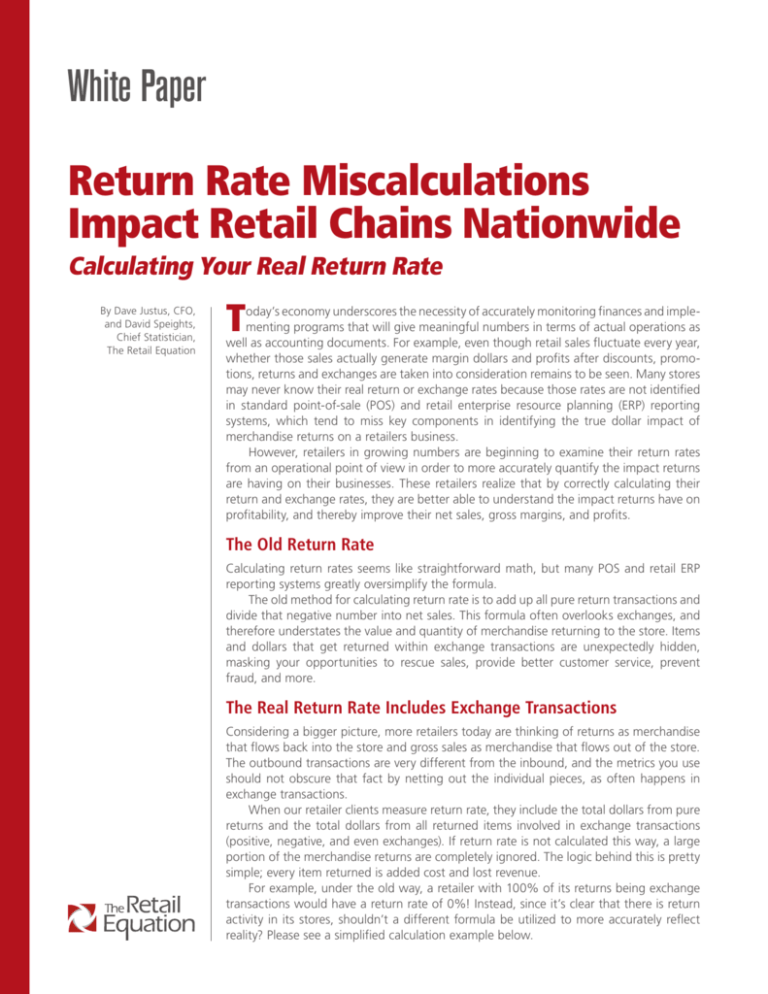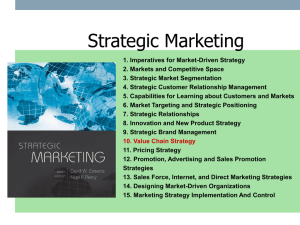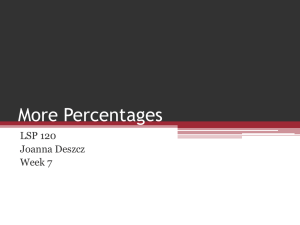
White Paper
Return Rate Miscalculations
Impact Retail Chains Nationwide
Calculating Your Real Return Rate
By Dave Justus, CFO,
and David Speights,
Chief Statistician,
The Retail Equation
T
oday’s economy underscores the necessity of accurately monitoring finances and implementing programs that will give meaningful numbers in terms of actual operations as
well as accounting documents. For example, even though retail sales ­fluctuate every year,
whether those sales actually generate margin dollars and profits after ­discounts, promotions, returns and exchanges are taken into consideration remains to be seen. Many stores
may never know their real return or exchange rates because those rates are not identified
in standard point-of-sale (POS) and retail enterprise resource planning (ERP) reporting
systems, which tend to miss key components in identifying the true dollar impact of
­merchandise returns on a retailers business.
However, retailers in growing numbers are beginning to examine their return rates
from an operational point of view in order to more accurately quantify the impact returns
are having on their businesses. These retailers realize that by correctly calculating their
return and exchange rates, they are better able to understand the impact returns have on
profitability, and thereby improve their net sales, gross margins, and profits.
The Old Return Rate
Calculating return rates seems like straightforward math, but many POS and retail ERP
reporting systems greatly oversimplify the formula.
The old method for calculating return rate is to add up all pure return transactions and
divide that negative number into net sales. This formula often overlooks exchanges, and
therefore understates the value and quantity of merchandise returning to the store. Items
and dollars that get returned within exchange transactions are unexpectedly ­hidden,
masking your opportunities to rescue sales, provide better customer service, prevent
fraud, and more.
The Real Return Rate Includes Exchange Transactions
Considering a bigger picture, more retailers today are thinking of returns as merchandise
that flows back into the store and gross sales as merchandise that flows out of the store.
The outbound transactions are very different from the inbound, and the metrics you use
should not obscure that fact by netting out the individual pieces, as often happens in
exchange transactions.
When our retailer clients measure return rate, they include the total dollars from pure
returns and the total dollars from all returned items involved in exchange transactions
(positive, negative, and even exchanges). If return rate is not calculated this way, a large
portion of the merchandise returns are completely ignored. The logic behind this is pretty
simple; every item returned is added cost and lost revenue.
For example, under the old way, a retailer with 100% of its returns being exchange
transactions would have a return rate of 0%! Instead, since it’s clear that there is return
activity in its stores, shouldn’t a different formula be utilized to more accurately reflect
reality? Please see a simplified calculation example below.
Example Calculations
Definitions
Purchase – This is a trans­
action that only includes
­purchased items and no
items are returned or
exchanged. The consumer
will owe money to the store
in this type of transaction.
SIMPLIFIED CALCULATION OF RETURN RATE
TRANS
TYPE
Purchase
Positive exchange
Purchase
Positive exchange
Return
TRANS
ID
LINE
ITEM
SKU
LIST
PRICE
00001
DISCOUNTS
EXTENDED
AMOUNT
001
1234567
$29.99
$0.00
$29.99
002
1234567
$33.33
$0.00
$33.33
003
2345555
$59.99
$0.00
$55.99
004
1111111
$24.99
–$10.00
$14.99
001
444444
–$29.99
$0.00
–$29.99
002
555555
–$21.99
$3.00
–$18.99
00002
003
444444
$29.99
$0.00
$29.99
004
555555
$21.99
$0.00
$21.99
001
1234567
$89.99
$0.00
$89.99
002
2345555
$59.99
$0.00
$55.99
00003
00004
001
1111112
–$9.99
$1.99
–$8.00
002
2222222
$12.99
$3.00
$15.99
003
3333333
$19.99
$3.00
$22.99
004
4444444
$29.99
$3.00
$32.99
001
9999999
–$19.99
$0.00
–$19.99
002
8888888
–$7.99
$0.00
–$7.99
00005
Pure Return (Return) – This
is a transaction that only
includes returned items and
no items are purchased or
exchanged. The consumer
will receive money back in
this type of transaction.
Even Exchange – This is
a transaction that includes
returned items and purchased
items that are exactly equal
in value so that the total
transaction amount is $0.00.
No money will be exchanged
in this type of transaction.
Negative Exchange – This
is a transaction that includes
returned items and purchased
items where the dollar
amount of the returned
items exceeds the dollar
amount of the purchased
items. The consumer will
receive money back in this
type of transaction.
OLD RETURN RATE CALCULATION
Total Pure Returns
–$27.98
Total of only return transactions (exchanges excluded)
Net Sales
$319.27
Net total of all transactions
Old Return Rate
8.76%
Total Pure Returns divided by Net Sales
Positive Exchange – This is
a transaction that includes
returned items and purchased
items where the dollar
amount of the purchased
items exceeds the dollar
amount of the returned
items. The consumer will
owe money to the store in
this type of transaction.
REAL RETURN RATE CALCULATION
Total Returns
–$84.96
Total of all negative extended amounts
Gross Sales
$404.23
Total of all positive extended amounts
Net Sales
$319.27
Total of all extended amounts (Gross Sales + Total Returns)
Real Return Rate
21.02%
Total Returns divided by Gross Sales
This simplified example underscores the significant differences in return rate calculations,
and how the real return rate provides a clearer snapshot of what is happening in your stores.
The Impact On Your Business
When this emergent approach of measuring returns as all merchandise that flows back
into your store is compared to previous calculations, most retailers see a return rate
increase of 50% to 150%, dramatically highlighting the issue. By viewing returns in a
broader light, you receive:
n More visibility into item return trends and patterns, creating better merchandise
and customer service intelligence.
n Greater understanding of shopper behavior, enhancing CRM analysis.
n Stronger ability to spot and prevent return fraud and abuse.
n Improved capability to reduce return rate and thereby keep more revenue
(net sales dollars) in-store.
Our retail clients see fraud and abuse issues in both exchange and return transactions;
in fact, exchanges are very popular among fraudsters since exchanges are often scrutinized less (under the old return rate method which presumed exchanges were “safer”
2
t­ ransactions than returns). Since return fraud can be perpetrated in many transactions, the
fraud prevention tools you use and the method by which you calculate return rate must
account for exchanges, too. The Retail Equation’s Verify® return authorization and Receipt
­Verification™ solutions do account for exchanges and help prevent fraud and abuse in
merchandise returns of all types, keeping sales dollars from flowing out of your store.
Example of the Hidden Cost of Returns
One footwear retailer, for example, realized that the company was losing 1 percent of
sales each year to fraudulent and abusive merchandise returns. Executives saw an opportunity to improve overall profitability by tracking return transactions, reducing the amount
of refund dollars, creating incremental revenue and delivering positive customer service
during returns. Think of it this way—A consumer brings back one pair of shoes that have
been worn and are not defective and the consumer demands a refund. The selling price
of the shoes was $100 per pair; the cost of the shoes was $60 per pair; the gross ­margin
was $40 per pair; and the net profit was $10 per pair. The store has to write off this pair
of shoes. How many new pairs of shoes do you think that retailer will have to sell to
make up for the loss on the write off of the return? The answer is 10. The revenue on 10
pairs would be $1,000, which would cover the cost of the shoes (i.e. $600) plus the lost
margin of $400 and the operating expenses (i.e. $300) and yield the original 10 percent
net profit.
The vast majority of all returns are initiated by good consumers who repeatedly shop
at a given store or outlet. In fact, over 75 percent of all shoppers never even return
­purchases. However, the remaining 25 percent of “good” returns can be costly. Assuming
a 40 percent gross margin and a $100 item retail price for 20 items, a retailer will achieve
zero profit at a 20 percent return rate. The problem, for most retailers, is that their current
accounting programs do not accurately reflect their real return rates.
What is
Return Fraud?
A recent survey by the
National Retail Federation
found that return abuse and
fraud costs retailers $9-17
billion annually. This includes
“wardrobing” schemes in
which people buy a product
for the day and then return
it the next, and “price
arbitrage” schemes in which
boxes or items within boxes
are switched around so
people can buy higher-end
products for low-end prices.
In some cases, people forge
or steal receipts to “shoplist”
(e.g. shoplifting to match
specific items on a receipt)
for goods and then “return”
those items at the checkout
for cash; or they might
just bypass the receipts
completely, steal the goods
and “return” them without
a receipt for a refund or
exchange.
Analysis of Ten Major Retailers
The Retail Equation recently tallied up real return rates for 10 different retailers in order
to analyze how the retailers were viewing the impact of merchandise returns. Of the
10 retail clients under study, all were found to be underestimating their return rate—one
by as much as 150 percent, with an average return rate discrepancy of over 80 percent
(see table below), resulting in additional costs of over $462 million to a retailer doing
$10 billion in annual revenue. The problem was in using flawed math.
Anonymous
Client
Real Return
Rate Calculation
Old Return Rate
Calculation
Difference
#1
7.2%
4.2%
69%
#2
15.3%
8.6%
79%
#3
8.1%
5.4%
49%
#4
13.2%
9.5%
39%
#5
6.8%
3.7%
85%
#6
4.5%
2.5%
79%
#7
9.4%
4.7%
100%
#8
19.9%
11.7%
71%
#9
8.2%
3.7%
118%
#10
9.3%
3.7%
149%
Using the old method of calculating return rates, retailers were excluding exchanges from
their calculation. This method often understates the value and quantity of merchandise
being returned. Using this old methodology, retailers mistakenly assume that exchanges
show no impact on their business because no money changes hands and, on the ­surface,
3
they have no apparent affect on net sales. In reality, however, every item returned represents an added cost and a loss of revenue. Exchanges cost money in restocking fees,
in employee time, and in possible damage to goods. The new “real return rate” method
of calculating return rates includes the dollar value impact from pure returns, as well as
the total dollar value impact from all exchange transactions, whether they are positive
exchanges, negative exchanges or even exchanges. From an operational point of view,
this makes much more sense because it more precisely quantifies the impact of all returns
on the retailer’s business.
Knowing Accurate Return Rate Leads to Better Decisions
Presumably, most consumers would rather not go through the onerous process of returning or exchanging an item if they can avoid it. Therefore, it is important to understand
why a product is being returned or exchanged. For example, an even exchange may be
due to a defective product line, which not only costs the store in terms of money spent to
return the item to the supplier but also in terms of lost customer satisfaction and goodwill. If retailers can identify defective products, they can take action before the shelves
are stocked with those products, thus reducing their costs and increasing their revenues.
Another benefit of adequately tracking even exchanges is that it allows retailers to
more accurately evaluate their buying policies. For example, if a store notices that red shoes
are consistently being exchanged for blue shoes, it can reduce the number of red shoes it
orders and increase the number of blue shoes. Consumers will be happier because they
can find the items they really want, and the store will not waste time and money returning goods or having to discount prices to unload unwanted inventory. From a ­traditional
accounting point of view, the most important factor is the price of the shoe, not the color.
But from the consumer’s perspective, it probably does not matter how much the shoe
costs if it is not the right color. Only by looking at the operations from a consumer-based
perspective, can retailers get a real picture of what is going on and take steps to purchase
those items that truly address consumers’ needs and generate sales.
In short, while the effect of returns on retailer financial statements may seem
­negligible according to traditional methods, they are anything but insignificant. Failure to
accurately account for returns using a consumer-based, operational perspective can have
dramatic consequences in terms of the financial repercussions of underestimating costs
and in terms of the marketing repercussions of failing to maintain or grow a loyal consumer
base. Both of these are important in any given economy; however, in a recession, where
­margins are thinner than usual, it is imperative for retailers to have a clear picture their
true profits and losses.
PO Box 51373
Irvine, CA 92619-1373 USA
+1 (888) 371-1616
www.TheRetailEquation.com
The Retail Equation, Inc.
specializes in retail transaction optimization solutions, using statistical modeling and analytics
to predict ­consumer behavior.
The Retail Equation logo is a
trademark of The Retail Equation
Incorporated. Patents, pending
patents, trademarks, service marks
and registered trademarks referenced
herein are the property of The Retail
Equation Incorporated, including but
not limited to The Retail Equation,
Verify Return Authorization, Verify-1,
Verify-2, Verify-3, Receipt Verification,
Return Rewards, Purchase Rewards,
and Patent 6,016,480, 7,455,226
and 8,355,946.
© March 2013
The Retail Equation, Inc.,
All Rights Reserved.
TRE4015






![[DATE] Mary Ziegler Director Division of Regulations, Legislation](http://s3.studylib.net/store/data/007212021_1-b96b03cd98cadfc74a22865c0247494d-300x300.png)


